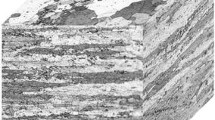Abstract
Residual stresses induced during quenching of aluminum alloys cause dimensional instability and distortion. In this study, the effects of different concentrations of polyalkylene glycol (PAG) quenchants on residual stresses and mechanical properties of 2024 aluminum alloy were investigated. Surface residual stresses were measured by using hole-drilling strain-gauge method. Also, mechanical properties and microstructure of the heat-treated samples were analyzed using hardness measurements, tensile tests, and transmission electron microscopy. Results showed that quenching into a 15% polymeric solution and aging at 190 °C for 12 h cause 50% reduction in residual stress as compared with quenching in water at 20 °C and naturally aging. Moreover, tensile strength decreased by 104 MPa (~ 20%) in compared with the T6 sample.






Similar content being viewed by others
References
C. Peel, Aluminium Alloys for Airframes–Limitations and Developments, Mater. Sci. Technol., 1986, 2(12), p 1169–1175
Z. Huda and N.I. Taib, Zaharinie T (2009) Characterization of 2024-T3: An Aerospace Aluminum Alloy, Mater. Chem. Phys., 2009, 113(2), p 515–517
J. Staley, Quench Factor Analysis of Aluminium Alloys, Mater. Sci. Technol., 1987, 3(11), p 923–935
D.A. Lados and D. Apelian, The Effect of Residual Stress on the Fatigue Crack Growth Behavior of Al-Si-Mg Cast Alloys—Mechanisms and Corrective Mathematical Models, Metall. Mater. Trans. A, 2006, 37(1), p 133–145
T. Croucher, Minimizing Machining Distortion in Aluminum Alloys Through Successful Application of Uphill Quenching—A Process Overview, Quenching and Cooling, Residual Stress and Distortion Controled, ASTM International, 2010
J. Vruggink, Quenching Rate Effects on Mechanical Properties of Heat Treatable Aluminum Alloys, Presented at the fall meeting of TMS (1968)
R. Blackwood, L. Jarvis, G. Totten, G. Webster, and T. Narumi, Reducing Aluminum Distortion with Type I, Quenchants, Met. Heat Treat., May/June 1996, p 28–31
J. Robinson and D. Tanner, Residual Stress Development and Relief in High Strength Aluminium Alloys Using Standard and Retrogression Thermal Treatments, Mater. Sci. Technol., 2003, 19(4), p 512–518
J. Robinson, R.L. Cudd, D. Tanner, and G. Dolan, Quench Sensitivity and Tensile Property Inhomogeneity in 7010 forgings, J. Mater. Process. Technol., 2001, 119(1), p 261–267
M. Koc, J. Culp, and T. Altan, Prediction of Residual Stresses in Quenched Aluminum Blocks and Their Reduction Through Cold Working Processes, J. Mater. Process. Technol., 2006, 174(1), p 342–354
T. Croucher, Uphill Quenching of Aluminum: Rebirth of a Little-Known Process, Heat Treat., 1983, 15(10), p 30–34
M. Araghchi, H. Mansouri, R. Vafaei, and Y. Guo, A Novel Cryogenic Treatment for Reduction of Residual Stresses in 2024 Aluminum Alloy, Mater. Sci. Eng., A, 2017, 689, p 48–52
A. Lu, F. Tang, X. Luo, J. Mei, and H. Fang, Research on Residual-Stress Reduction by Strong Pulsed Magnetic Treatment, J. Mater. Process. Technol., 1998, 74(1), p 259–262
S. Wu, H. Zhao, A. Lu, H. Fang, and F. Tang, A Micro-mechanism Model of Residual Stress Reduction by Low Frequency Alternating Magnetic Field Treatment, J. Mater. Process. Technol., 2003, 132(1), p 198–202
G. Sarmiento, C. Bronzini, A. Canale, L. Canale, and G. Totten, Water and Polymer Quenching of Aluminum Alloys: A Review of the Effect of Surface Condition, Water Temperature, and Polymer Quenchant Concentration on the Yield Strength of 7075-T6 Aluminum Plate, Quenching and Cooling, Residual Stress and Distortion Controled, ASTM International, 2010
T. Croucher, Using Polyalkylene Glycol Quenchants to Effectively Control Distortion and Residual Stresses in Heat Treated Aluminum Alloys, J. ASTM Int., 2010, 1523, p 309–331
Strain Guage ed., TML, Ed., Tokyo Sokki Kenkyujo Co., Ltd. (2016)
G. Totten, C. Bates, and L. Jarvis, Type I, Quenchants for Aluminum Heat Treating, Heat Treat., 1991, 23(12), p 16–19
G. Totten and D. Mackenzie, Aluminum Quenching Technology: A Review, Mater. Sci. Forum, 2000, 331, p 589–594
H. Tensi, A. Stich, and G. Totten, Fundamentals of Quenching, Met. Heat Treat., 1995, 2(2), p 20–22
R. Ikkene, Z. Koudil, and M. Mouzali, Cooling Characteristic of Polymeric Quenchant: Calculation of HTC and Prediction of Microstructure and Hardness, J. Mater. Eng. Perform., 2014, 23(11), p 3819–3830
Z. Feng, Y. Yang, B. Huang, M. Han, X. Luo, and J. Ru, Precipitation Process Along Dislocations in Al-Cu-Mg Alloy During Artificial Aging, Mater. Sci. Eng., A, 2010, 528(2), p 706–714
V. Radmilovic, G. Thomas, G. Shiflet, and E. Starke, On the Nucleation and Growth of Al2CuMg (S′) in Al-Li-Cu-Mg and Al-Cu-Mg Alloys, Scr. Mater., 1989, 23(7), p 1141–1146
J.F. Nie, B.C. Muddle, and I.J. Polmear, The Effect of Precipitate Shape and Orientation on Dispersion Strengthening in High Strength Aluminium Alloys, Mater. Sci. Forum, 1996, 217–222, p 1257–1262
J. Robinson, D.A. Tanner, S. Van Petegem, and A. Evans, Influence of Quenching and Aging on Residual Stress in Al-Zn-Mg-Cu Alloy 7449, Mater. Sci. Technol., 2012, 28(4), p 420–430
S. Ringer, T. Sakurai, and I. Polmear, Origins of Hardening in aged Al-Cu-Mg-(Ag) Alloys, Acta Mater., 1997, 45(9), p 3731–3744
S. Wang, M. Starink, and N. Gao, Precipitation Hardening in Al-Cu-Mg Alloys Revisited, Scr. Mater., 2006, 54(2), p 287–291
Author information
Authors and Affiliations
Corresponding author
Rights and permissions
About this article
Cite this article
Araghchi, M., Mansouri, H., Vafaei, R. et al. Optimization of the Mechanical Properties and Residual Stresses in 2024 Aluminum Alloy Through Heat Treatment. J. of Materi Eng and Perform 27, 3234–3238 (2018). https://doi.org/10.1007/s11665-018-3400-0
Received:
Revised:
Published:
Issue Date:
DOI: https://doi.org/10.1007/s11665-018-3400-0




